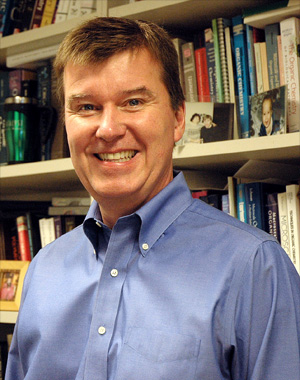 David Hansen, who has just served his first year as the Weinberg Family Dean of Science for the Joint Science Department (JSD), has taken a curious approach to his career as a science educator.
David Hansen, who has just served his first year as the Weinberg Family Dean of Science for the Joint Science Department (JSD), has taken a curious approach to his career as a science educator.
“I’m very, very squeamish,” Hansen admits, “and I didn’t take biology in high school. I didn’t like science any more than any other subject, but I took chemistry my first year at Brown [University], then biology as a sophomore. That’s when the die was cast. I immediately saw the connections between the two.”
Essentially, Dean Hansen has followed a process-of-elimination approach. He pursued science until it pursued him, and he wound up as a bio-chemistry major entranced by the surprises science offered. After earning his Ph.D. in chemistry from Harvard, he interviewed at Amherst College simply to eliminate liberal arts colleges as a possible career path. Twenty-four years later, having successfully and happily taught at Amherst all those years, Hansen went on a “fact-finding mission” to the Joint Science Department of the Claremont Colleges last spring, never intending to actually change jobs.
“I was so impressed with the department, and the energy was so remarkable,” Hansen explains, “that I saw it was a truly unique opportunity.”
Although Amherst College is also part of a five-college consortium of colleges, the Joint Science Department offered a more intensely interdisciplinary and integrated program for students from Scripps, Claremont McKenna, and Pitzer Colleges. The colleges pooled their resources to create the largest academic department in Claremont, housed in the W.M. Keck Science Center, which is located at the nexus of the three colleges.
Since 2005, Scripps has had the greatest number of science majors among the 3 member colleges, proportionate to its size. The number of science majors at Scripps has been growing over the past ten years, hitting a peak last year with 47, or 21% of the senior class. During those years, the number of female faculty members has also increased at a rate three times that of male hires.
Besides the challenge of serving three distinct institutions, Hansen was attracted to the exciting environment in the Keck Science Center, where biologists bump into chemists by the copy machine, and physicists chat with environmental scientists in the hallways.
“Having biology, chemistry, and physics under one roof just leads to intellectual ferment,” explains Hansen. “The disciplines truly work together, and, although it may seem trivial, the proximity is so critical.”
JSD offers over a dozen majors built on the foundations of biology, chemistry, and physics, many of which reflect the multidisciplinary nature of the department and of the Claremont Colleges as a whole. A particularly innovative course, Accelerated Integrated Science Sequence (AISS), offers first-year students the opportunity to take a year-long, honors-level course co-taught by a biologist, chemist, and physicist. Developed with the support of a National Science Foundation grant, AISS provides students with the tools to successfully approach topics in neurobiology or nanotechnology, for example, from a multidisciplinary perspective.
Adam Landsberg, a physics professor who taught AISS last year, notes the positive impact that Dean Hansen has had on the department by “hitting the ground running. He oversaw two successful tenure-track faculty searches for our growing department, is in the final phases of putting together a prestigious Joint Science Advisory Board comprising leading scientists from across the country, and has helped launch the new JSD website.Confidence, cooperation, and morale in the department are very high, in part because of David’s diplomacy and leadership.”
For his part, Dean Hansen calls his new academic home “a very supportive environment.” As a “huge proponent of the liberal arts,” he advises students to study science for the same reason they should study history or a fine art: “to be exposed to different ways of thinking about the world. Science isn’t a better way, but it is unique. Intellectual pluralism, which is an aim of the liberal arts, leads to an appreciation of other views. And studying at a liberal arts college, rather than a research university, provides direct interaction between faculty and students. People are just here talking, in the Keck Science Center, all the time.”
For someone whose career was sparked by seeing the connections between biology and chemistry, Dean Hansen has found an academic home in the Joint Science Department, where talking across the disciplines is just about unavoidable.

